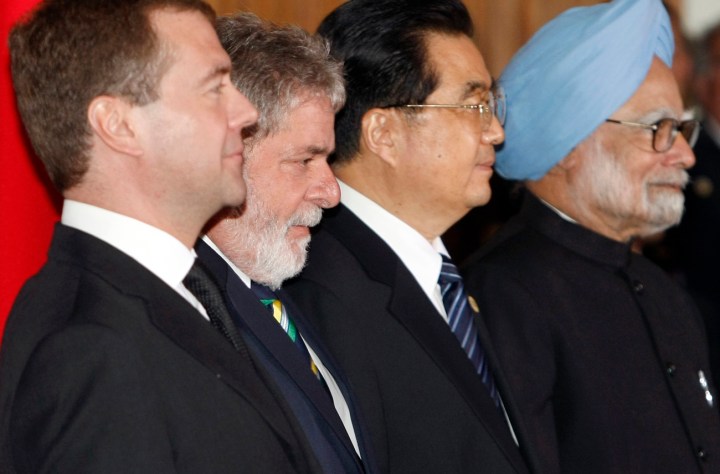Business Maverick, Politics
Being part of Bric could help SA smash many walls

While the hurly-burly of global trade, the cut and thrust of big-brute countries versus the agility and versatility of the little guys, continues like some epic movie battle scene, It is wise to pick your sides cautiously. If you pick sides at all. By BROOKS SPECTOR.
Foreign policy scholar and rapidly ascending media star Fareed Zakaria (born in India and now in the American and international big time as a senior commentator for Time magazine and CNN) wrote in his recent Washington Post column that although promoters of the new Bric (Brazil, Russia, India and China) constellation see the grouping as the Next Really Big Thing in international economic affairs, in Zakaria’s view, this group of nations has effectively warded off real efforts to act like big boys and pull their weight internationally in the global interest. Instead, they have pursued the same old same old; traditional, narrow self-interest. Zakaria asks, for example, where is any real Bric leadership on international trade, energy, climate change negotiations or even regional stability issues.
Perhaps nowhere is Zakaria’s criticism more stinging right now than right here in South Africa – a nation making a concentrated push to add an “SA” to the “Bric” lapel pin and, simultaneously, assert regional, even continental, leadership in Africa.
In particular, Zakaria chastises South Africa: “Many of these countries want to be deferred to on matters of regional peace and stability. Yet they continue to pursue their national interests even more zealously. Perhaps the most egregious example is South Africa, which insists that it is Africa’s natural leader. Yet the country has been shamefully absent in the efforts to rescue the people of Zimbabwe and Sudan from the tragedies unfolding in their lands.”
Zakaria’s thesis received a quick rejoinder from Foreign Policy magazine’s contributing editor David Bosco, in his column “The Multilateralist”. (Zakaria used to be a bigwig at Foreign Policy so maybe there was a bit of the old “let’s tweak the nose of our former boss and colleague” as well.) Bosco wrote that while he was sympathetic to some of Zakaria’s ideas, Zakaria’s “argument very easily collapses into an insistence that emerging powers see the world as the established ones do before they’re given the reins of power”. Bosco added: “Is it fair to say of Brazil or South Africa that they shouldn’t be given more say in key institutions until they accept a certain view of the relative importance of environmental protection and economic growth or the balance between national sovereignty and human rights?” Interesting question…
This writer has a memory that goes back to the height of the Cold War. More than once he had to sit through lectures, presentations (and the odd harangue) by Nixon administration flacks and sympathetic international relations analysts who came to Southeast Asia to preach “The Gospel of the Regional Hegemon”. The idea was that a small group of regional powers (usually avid consumers of US military hardware) would do the local heavy international security lifting in their respective regions around the globe. These local powers included (a pre-Khomeini, pre-Ahmadinejad) Iran, Saudi Arabia, Morocco, Egypt, Indonesia, Brazil and maybe, just maybe, South Africa, but only if it would learn to behave like a good boy once in a while. These were more a state-to-state arrangement and slid past the need for those cumbersome multilateral treaties.
But they followed logically upon that earlier series of interlocking, globe-girdling regional security alliances following World War II, as the Cold War began to catch hold. At first, for those earlier multinational treaties, that began with Nato for Europe and the North Atlantic; then Seato for Southeast Asia, Anzus for the South Pacific and a reinforced OAS for Latin America; and then Cento for the Middle East and South Asia. The Soviet-led Warsaw Pact counterbalanced these US-led efforts; and then the third world’s Non-Aligned Movement was called into being in the 1950s to offset the Eastern and Western blocs.
As the Cold War drew to a close, the world’s focus turned to economics and trade in the new era at “the end of history”, in the words of Francis Fukuyama’s catchy, but ultimately less-than-helpful phrase. Once the Cold War was history, the EU quickly began to take on additional members (although Nato did too to build a more integrated security architecture for Europe), Apec (the curiously ungrammatical Asia Pacific Economic Cooperation –the word Forum was added later) bulked up quickly, as did the G-7 as it morphed into the G-8 and then added eager siblings, the G-20.
The EU, Apec and the G-whatever-the-number actually had – and continue to have – some real tasks to carry out. The EU swept away trade barriers and continues to attempt to balance and harmonise national finance, investment and economic growth policies across Europe. Apec provides a wide-ranging forum for trade discussions and negotiations for virtually every nation of the Pacific Rim, and the G-7, 8 or 20 provides a way for the more developed, industrialised nations to speak with something approaching a common voice in dealing with the rest of the world. These groupings arose organically out of common interests and concern. They have gathered influence in developing a momentum to tackle larger international topics with more weight than any one nation can usually achieve, but in a more flexible environment than can be achieved at the UN or under World Bank or IMF auspices.
The idea of the Bric grouping, of course, did not simply come out of thin air. And so it shouldn’t be too surprising to discover that it was an invention a decade ago, of, wait for it, Goldman Sachs – in part, perhaps, as a way to sell new, go-go investments. You can just about hear the bond traders whispering into their headsets now: “Psst! Get in on the ground floor of the next big thing. Wanna be the first in your crowd to buy into this group of rapidly growing countries?”
Bric – maybe they came up with a marketing ploy like selling exclusive (but much bigger) beachfront timeshares. Or perhaps sub-prime mortgage collateralised investment vehicles. Or Russian, Chinese and Mexican railroad bonds, tulip bulbs, or prime real estate available only through that Great South Seas or that old Mississippi investment scheme. Soon rivals to Goldman Sachs, like HSBC and Deutsche Bank’s fund unit DWS, were launching dedicated investment funds marketed under the label of Bric as well. “We asked our lawyers if we could trademark the word ‘Bric’, but they said not – apparently it’s not a product,” Goldman Sachs’ Paul O’Neill is reported to have said later.
Follow this skein backwards a bit further and soon you get to an earlier version of nearly the same marketing concept – only this time it was the Big Emerging Markets boom that included all the Bric (save for Russia), plus a dozen or so nations like South Korea and Indonesia. Again, a way to attract and guide direct foreign investors and sell those stocks and bonds. And it too shouldn’t come as too much of a shock that investment consultants, in tandem with the Clinton go-go foreign investment enthusiast, secretary of commerce Ron Brown, took the lead.
The underlying argument then was that with the Cold War over, investment, trade, growth would be the next big thing, bringing the national lions and lambs together – but one had to get in early for the good stuff. There was surface plausibility here. All of these countries were growing fast, they were loosening up their capital markets, there were lots of new opportunities in primary commodities, banking, and manufacturing, even agricultural sector restructuring. And the returns were better than in America, Germany, the UK or France…. Or, as then-president Clinton described his government’s new US National Export Strategy directed at those Big Emerging Markets, it was “a comprehensive plan that upgrades and coordinates the government’s export promotion and export finance programs to help American firms compete in the global marketplace.” No more wars, developed country economies a little slack? No problem, the Big Emerging Markets beckon.
Let me pause for a personal memory. Just as China had been christened a founder member of the Big Emerging Markets tribe, I happened to see a government telegram (those things we used before email) gushing on about the opening of eight new stock markets in China. China! Communist Party general secretary Deng Xiaoping was right – “To be rich is glorious!”
For some reason, I got it into my head that I wanted to buy some Chinese stocks as the way to make my own personal fortune. And so, together with a couple of other would-be pioneer investors, we spent days trying to find a stockbroker who would do the necessary for us so we could buy a bunch of shares in the National Brewing Company on the brand-spanking-new Lhasa Stock Exchange in Tibet. Hey, anybody can invest in Shanghai, but Tibet! Be the first to invest in a really exotic place – shades of James Hilton’s “Lost Horizon”! But we simply couldn’t find a broker would do the required legwork for us. Of course, now you can do it yourself on the Internet, but that was back then. Don’t know what happened to that stock, though.
But this idea of new countries and new investors looking for their moment in history has a lot more, well, history in it than just the post-Cold War investment casino. A hundred-and-ten years ago, German Kaiser Wilhelm II basically staked out the catch phrase on the then-new emerging market phenomenon – but from the perspective of the emerging market rather than a would-be investment shill. As Kaiser Willie told a German nation that had just surpassed the UK as a economy, was growing fast and was clearly on its path towards a great future: “We have conquered for ourselves a place in the sun. It will now be my task to see to it that this place in the sun shall remain our undisputed possession, in order that the sun’s rays may fall fruitfully upon our activity and trade in foreign parts, that our industry and agriculture may develop within the state and our sailing sports upon the water, for our future lies upon the water….”
Well, he was speaking to a bunch of yachting enthusiasts so maybe he got a little carried away with those sailing metaphors, but never mind, his idea of a place in the sun motivated new, ambitious nations like Germany, Italy and Japan to get in on the empire business. And this “place in the sun” metaphor gained some real staying power.
In fact, this nascent new world idea even has a footnote in US history. Back at the beginning of the American Revolution, George Washington, seeing the new American flag for the first time (the one with thirteen stars in a circle), was reported to have hailed it “a new constellation in the heavens”. Then, five years later, as British General Cornwallis marched out in defeat at the siege of Yorktown in 1781, his army’s drum and bugle corps reputedly played that old 18th century “top of the pops” hit, “The World Turned Upside Down”, marking the precise moment of the creation for a new order on the face of the globe. The basic idea clearly has been around for a while.
But to return to where we began – with Bric – what does this group actually have in common? We owe Business Day columnist Tim Cohen a nod of acknowledgement for noting last week that Bric is simply a marketing ploy. Let’s take a quick look at the facts. China and India do indeed share very large populations of more than a billion people each. But China has a significantly higher per capita income and the two countries have almost diametrically opposite political systems. And while their rates of growth are similar, although India was on the graph earlier, China has made its impact by moving up the value chain of manufactured goods while still operating in what remains significantly a command economy where the government steers capital to new investments. By contrast, India has gone into software and IT-based backroom operations, taking advantage of a large pool of English-speaking Indians, living in a rambunctious, largely capitalist state. This week’s The Economist, in fact, is hedging its bets and putting more chips on India for the future.
Further down the list, Russia’s growth has largely been fuelled by primary mineral and oil/natural gas exports – Russian computer components and fashion are not exactly setting the world on fire yet. Brazil, however, seems to have found something of a sweet spot. It has staked out a middle path through all this – it is firmly democratic, has a stable investment climate, major mineral and innovative agricultural exports, as well as growing high tech export sectors such as aeronautics.
But why not a whole range of other nations for a BRIC+SK+U+C+T+I…? Indonesia is also a very large nation with more than 250 million people, an increasingly stable democratic regime, a major agricultural sector and great mineral deposits, a rapidly growing industrial sector and – generally – solid growth rates. Chile is smaller, but its stability and growth rate are equally impressive. Then, too, it is easy to overlook South Korea in geographical size, but its 70 million people have created a global industrial giant whose products are everywhere. Or what about Turkey – the increasingly pre-eminent Middle Eastern economy? Or even the Ukraine, for that matter? And if we are looking for countries with huge populations and enormous energy resource potential there is always Nigeria – after all, South Africans are investing there. And it is easy to elide around Iran, but it is a relatively sophisticated, potentially nuclear-armed society that was a world power when Europeans were essentially living in huts.
The point, of course, is that the Bric phenomenon is a nifty catch phrase, but it clouds more than it clarifies. For South Africa to be a part of it would mean really trying to exercise weight it does not yet have. Too often, South Africa gets all those bonus points for its large economy, vis-à-vis the rest of Africa (that’s true of course), but perhaps some of its lustre lingers on (without putting too fine a point on it) from the remaining impact of the old regime’s military heft or the highly emotive quality of the moral stature of Nelson Mandela in world affairs?
Being a real Bric (whatever that may mean) and in competition for trade and investment with India, Brazil or China, is not going to come from just adding that “SA”. And, after all, does this country really want to be an enthusiast of an emerging world order in which global policing increasingly is handled by Russia and China in contrast to the US and in which the tsunami of cheap Chinese manufacturers has even more impact on South Africa? Even if one is not a cheerleader for America’s misbegotten adventures in Iraq and Afghanistan, the thought of a Chinese “blue water navy” patrolling the sea-lanes of the Pacific and creating and then enforcing the rules, should at least give pause.
Ultimately, maybe South African leaders should just try to be more effective in the country’s role as the default leader of SADC and in the AU, as a UN member, as an active negotiator in the next discussions in the Doha trade round and at the G-20 table, and so forth. Or, perhaps we should just cut to the chase and recall Groucho Marx’s famous comment when he said: “I don’t care to belong to a club that accepts people like me as members!” DM
For more on this debate, read: Foreign Policy, The Washington Post, The Washington Post, The Washington Post, The Washington Post, Business Day, The Economist, The Economist, SUNY-Albany and Fordham, as well as quirkier blogs like Bozongo, Global Research.
Photo: Russia’s President Dimitry Medvedev, Brazil’s President Luiz Inacio Lula da Silva, China’s President Hu Jintao and India’s Prime Minister Manmohan Singh pose for a photocall at the Itamaraty Palace in Brasilia April 15, 2010. REUTERS/Paulo Whitaker.


















 Become an Insider
Become an Insider